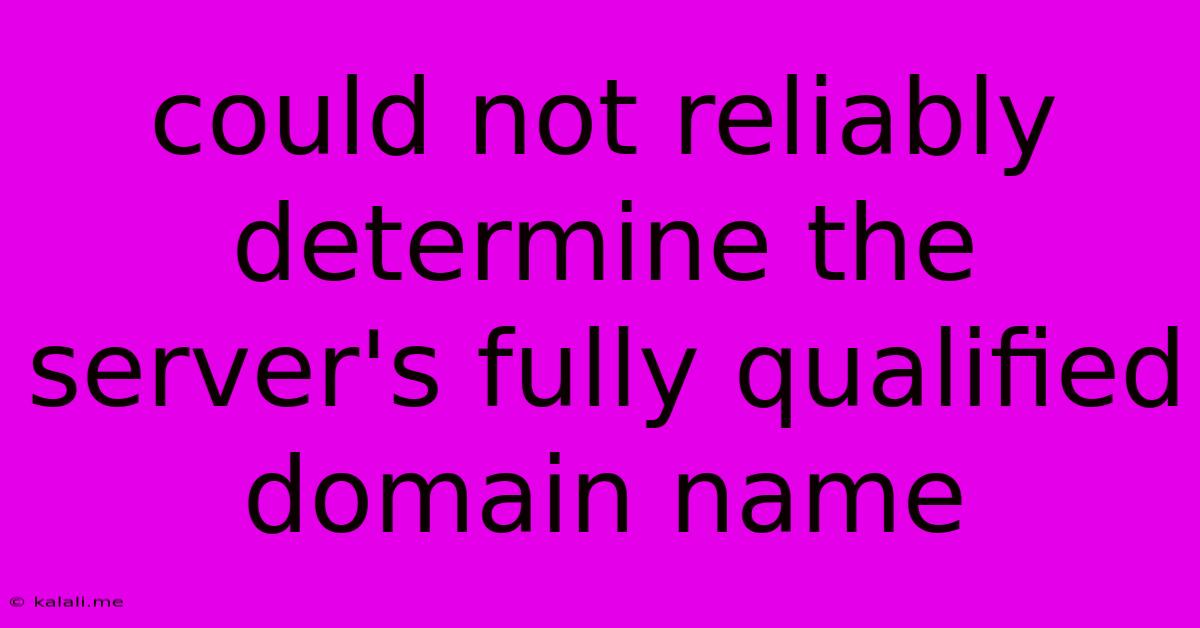Could Not Reliably Determine The Server's Fully Qualified Domain Name
Kalali
Jun 07, 2025 · 3 min read

Table of Contents
Could Not Reliably Determine the Server's Fully Qualified Domain Name: Troubleshooting and Solutions
This error, "Could not reliably determine the server's fully qualified domain name," is a frustrating one, often popping up when trying to connect to a network server or accessing certain online services. It essentially means your computer can't verify the server's identity. This article delves into the common causes and provides effective troubleshooting steps to resolve this issue. This issue affects various operating systems, including Windows, macOS, and Linux distributions. Understanding the underlying causes and implementing the appropriate solutions can save you significant time and frustration.
What Causes This Error?
The root of the problem lies in the inability of your computer to properly resolve the server's domain name. Several factors can contribute to this:
-
DNS Server Issues: Your computer relies on a DNS (Domain Name System) server to translate domain names (like
google.com) into IP addresses (like172.217.160.142). If your DNS server is malfunctioning, unavailable, or misconfigured, it will be unable to resolve the server's FQDN (Fully Qualified Domain Name), leading to the error. This is often the most common cause. -
Network Connectivity Problems: If you're having broader network connectivity issues, such as a poor internet connection or a problem with your network adapter, you might encounter this error. The computer simply cannot communicate with the server to obtain its FQDN.
-
Firewall or Antivirus Interference: Overly restrictive firewall rules or antivirus software can sometimes block the necessary communication for DNS resolution, resulting in the error message.
-
Incorrect Network Configuration: Incorrectly configured network settings on your computer, including incorrect IP address, subnet mask, or default gateway, can prevent the proper resolution of the server's FQDN.
-
Server-Side Problems: While less common, the problem might originate from the server itself. The server might have DNS configuration problems or be temporarily unavailable.
Troubleshooting Steps
Let's tackle how to resolve this error. Here’s a step-by-step guide:
1. Check Your Internet Connection:
- Ensure you have a stable internet connection. Try accessing other websites to rule out general connectivity problems.
2. Verify DNS Server Settings:
-
Windows: Open Network Connections, right-click your network adapter, select Properties, then Internet Protocol Version 4 (TCP/IPv4). Check if you're using automatic DNS server assignment (DHCP) or manually assigned addresses. Try switching between the two. You can also try using public DNS servers like Google Public DNS (8.8.8.8 and 8.8.4.4) or Cloudflare DNS (1.1.1.1 and 1.0.0.1).
-
macOS: Go to System Preferences > Network. Select your network connection and click Advanced. Go to the DNS tab and modify your DNS server settings as described above for Windows.
-
Linux: The process varies depending on your distribution, but generally involves editing network configuration files (like
/etc/resolv.conf) or using your distribution's network management tool.
3. Temporarily Disable Firewall and Antivirus:
- Temporarily disable your firewall and antivirus software to see if they're interfering. Remember to re-enable them afterward. If this solves the problem, you'll need to configure your security software to allow the necessary network traffic.
4. Restart Your Computer and Network Devices:
- A simple restart can often resolve temporary glitches. Restart your computer, your modem, and your router.
5. Check Network Adapter Drivers:
- Outdated or corrupted network adapter drivers can cause connectivity issues. Check your device manager (Windows) or system information (macOS/Linux) to ensure your drivers are up-to-date.
6. Flush DNS Cache:
- This clears any cached DNS entries that might be causing the problem. The commands vary slightly depending on your operating system (e.g.,
ipconfig /flushdnson Windows,sudo dscacheutil -flushcache; sudo killall -HUP mDNSResponderon macOS).
7. Advanced Troubleshooting:
- If the problem persists, more advanced troubleshooting might be necessary, including checking network cables, examining network configuration files, and potentially seeking assistance from a network administrator or IT support.
By systematically following these troubleshooting steps, you should be able to resolve the "Could not reliably determine the server's fully qualified domain name" error and restore your network connectivity. Remember to always prioritize secure network practices and keep your security software up-to-date.
Latest Posts
Latest Posts
-
Does Copying A Spell Count As Casting
Jun 08, 2025
-
How Do You Get Chewing Gum Off Trousers
Jun 08, 2025
-
Percy Jackson Greek And Roman Gods Description
Jun 08, 2025
-
Burnt Milk On Glass Top Stove
Jun 08, 2025
-
Add Light To 3 Way Switch
Jun 08, 2025
Related Post
Thank you for visiting our website which covers about Could Not Reliably Determine The Server's Fully Qualified Domain Name . We hope the information provided has been useful to you. Feel free to contact us if you have any questions or need further assistance. See you next time and don't miss to bookmark.